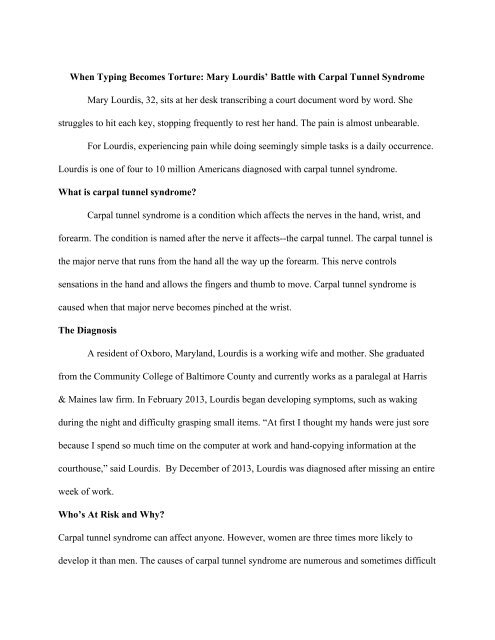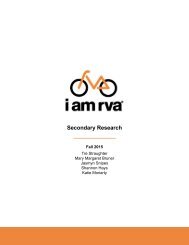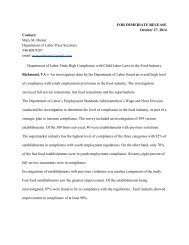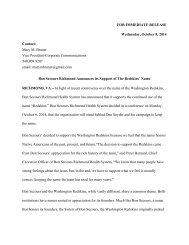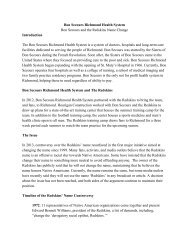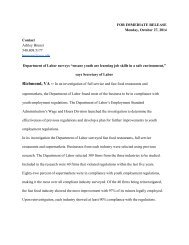You also want an ePaper? Increase the reach of your titles
YUMPU automatically turns print PDFs into web optimized ePapers that Google loves.
When Typing Becomes Torture: Mary Lourdis’ Battle with Carpal Tunnel Syndrome<br />
Mary Lourdis, 32, sits at her desk transcribing a court document word by word. She<br />
struggles to hit each key, stopping frequently to rest her hand. The pain is almost unbearable.<br />
For Lourdis, experiencing pain while doing seemingly simple tasks is a daily occurrence.<br />
Lourdis is one of four to 10 million Americans diagnosed with carpal tunnel syndrome.<br />
What is carpal tunnel syndrome?<br />
Carpal tunnel syndrome is a condition which affects the nerves in the hand, wrist, and<br />
forearm. The condition is named after the nerve it affectsthe carpal tunnel. The carpal tunnel is<br />
the major nerve that runs from the hand all the way up the forearm. This nerve controls<br />
sensations in the hand and allows the fingers and thumb to move. Carpal tunnel syndrome is<br />
caused when that major nerve becomes pinched at the wrist.<br />
The Diagnosis<br />
A resident of Oxboro, Maryland, Lourdis is a working wife and mother. She graduated<br />
from the Community College of Baltimore County and currently works as a paralegal at Harris<br />
& Maines law firm. In February 2013, Lourdis began developing symptoms, such as waking<br />
during the night and difficulty grasping small items. “At first I thought my hands were just sore<br />
because I spend so much time on the computer at work and handcopying information at the<br />
courthouse,” said Lourdis. By December of 2013, Lourdis was diagnosed after missing an entire<br />
week of work.<br />
Who’s At Risk and Why?<br />
Carpal tunnel syndrome can affect anyone. However, women are three times more likely to<br />
develop it than men. The causes of carpal tunnel syndrome are numerous and sometimes difficult
to diagnose. Realistically, carpal tunnel syndrome is often the result of a combination of factors<br />
that all increase pressure on the nerve. Things like repeated use of power tools, work stress or<br />
injury to the wrist can cause carpal tunnel syndrome. However, it can also be caused by more<br />
severe things like rheumatoid arthritis, a cyst or tumor in the carpal tunnel, or diabetes.<br />
It’s a common belief that heavy computer use causes carpal tunnel syndrome. In 2006, a study<br />
done by the Mayo Clinic found that heavy computer use (up to seven hours a day) did not<br />
increase the risk of developing carpal tunnel syndrome.<br />
The risk of developing carpal tunnel syndrome does not exist only within one field of work. It is<br />
true, however, that people who work on assembly lines are three times more likely to develop<br />
carpal tunnel syndrome than those who work mainly at a computer.<br />
Mary Lourdis has a potent combination of two of these risk factors present, making her risk of<br />
developing carpal tunnel syndrome very high. First, Lourdis is diabetic, which affects the body’s<br />
nerves and increased her risk. Second, rheumatoid arthritis runs in her family. Not to mention,<br />
Lourdis is a female, tripling her risk.<br />
What to Watch For<br />
Like Mary Lourdis, carpal tunnel sufferers often say that carpal tunnel syndrome<br />
symptoms often start graduallyburning, tingling, or itching in the palm of the hand and fingers.<br />
Usually, the symptoms begin appearing during the night, in one or both hands.<br />
As previously stated, women are more likely to develop carpal tunnel syndrome than<br />
men. “Women in particular should be on the lookout for certain symptoms that begin as minor<br />
nuisances and gradually worsen,” said Dr. Stephen Ambrose, Lourdis’ physician.<br />
Living with Carpal Tunnel Syndrome
It’s taco night at the Lourdis house. Mary Lourdis stands in the kitchen, chopping vegetables for<br />
their mini taco bar. She’s nearly finished chopping when she calmly sets down her knife, wipes<br />
her hands and takes a break. Her husband asks if she is OK. She explains, with a defeated tone,<br />
that her wrists and hands were bothering her too much to finish.<br />
The pain Lourdis experiences when doing simple tasks at work and at home is shared by<br />
many other carpal tunnel syndrome sufferers. “The pain can interfere with my job, things I like<br />
to do in my personal life, and even taking care of my daughter,” said Lourdis.<br />
Carpal tunnel syndrome can be treated. Treatment for the disorder ranges. At first.<br />
stretching and strengthening exercises can help in both preventing carpal tunnel syndrome and<br />
treating mild symptoms. In special circumstances various drugs are used to ease pain and<br />
swelling associated with carpal tunnel syndrome. Studies have also found that yoga reduces pain<br />
and improves grip strength among patients with carpal tunnel syndrome.<br />
There are also surgical treatments for carpal tunnel syndrome. In fact, carpal tunnel<br />
release is one of the most common surgical procedures in the United States. Surgery is usually<br />
done on both of the hands and is recommended if symptoms last for six months or more.<br />
“There is no reason to live with the pain of this disorder, which can be debilitating but is<br />
also treatable,” said Dr. Tom Starnes, Research Director for the National Institute for<br />
Neurological Disorders and Stroke.<br />
For Mary Lourdis, surgery is the last resort. Currently, Lourdis uses antiinflammatory<br />
drugs, occasional steroid injections and regular exercise to manage her symptoms. “It takes a lot<br />
of effort to keep the symptoms under control but I am hoping to avoid surgery,” said Lourdis.<br />
Researching Carpal Tunnel Syndrome
Research is being done to help better understand, prevent and treat carpal tunnel syndrome.<br />
Clinical trials of drugs and procedures are done to determine how best to treat carpal tunnel<br />
syndrome. Currently, scientists are testing the use of alternative therapies, like acupuncture, to<br />
prevent and treat carpal tunnel syndrome. “We know much more about carpal tunnel syndrome<br />
than just a few years ago, from symptoms and susceptibility to diagnosis to treatment,” said Dr.<br />
Tom Starnes.<br />
Mary Lourdis sits by her oneandahalf yearold daughter’s crib, reading her a story as she falls<br />
asleep. She struggles to turn each pain, gritting her teeth through the pain. She has conquered the<br />
pain another day.


